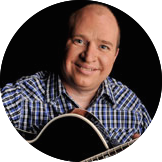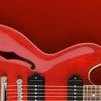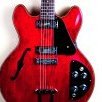
Triple-o
Members-
Posts
538 -
Joined
-
Last visited
-
Days Won
29
Content Type
Profiles
Forums
Gallery
Events
Articles
Blogs
Downloads
Everything posted by Triple-o
-
Have you ever noticed that you can play minor arpeggios two notes per string. Look at the Am7 starting on 6th string A. First I guess we should mentioned the notes A C E G. Now look at the 6th string A and C then the 5th string E and G then 4th string, 3rd string etc. The “puzzle board” is full of surprises.
-
Thanks, the video was really good.
-
I came across drop 2 voicing and this is away of finding playable chords on the neck. It looks pretty good, if you’re not familiar, I suggest you google the term. I am working on an iPad and “copy and paste” don’t seem to be an option.
-
Bb 9 played on the first fret. A movable chord that seems to break the rules. Perhaps my mind is just slip slid’ n away, but I was thinking movable meant no open strings. I played this chord before and never made the connection with the movable shape.
-
I think they are real helpful. Steve introduced them indirectly by using chords without the 5th. He didn’t refer to them as “shell voicings” if I remember correctly, so when I discovered “shells” I thought they were something new. Jens Larson also has a utube Jazz lesson using them.
-
This Jazz language concept hasn’t made sense to me yet. I find it strange every Jazz book I pick up talks about it, but none has dedicated even one sentence to expand on One university Jazz teacher said he couldn’t define it. He was concerned because all his students sounded the same, because they spend all their time copying Jazz legends. Another teacher quoted Lennie Tristram “don’t let an over emphasis on language limit self expression,make music your own. I read about a medical study where two jazz musicians were “trading fours” while one was in an MRI machine. It clearly showed that they used parts of their brain that are triggered by a spoken language, but not a tied to a spoken meaning. Oh yea, he was using a plastic keyboard and the medical facility was John Hopkins. One thing I know for sure. I can’t order a pizza speaking Jazz.
-
Lately I’ve been taking another look at double stops.This is one technique that I have failed to grasp and appreciate. In the blues where the 7th chords are so “dominant “ I am beginnng to see the connection between the them and double stops.They really can add to that blues sound. My practice sessions don’t need to double in time, but they clearly need the double stop.
-
I can see that trying to write something Clever has backfired. Here is a translation of what I was trying to say. “Improvising is like speaking off the cuff, which is easy enough when you know your topic well. Knowing the chord progression is like knowing your topic”. Jane Miller, guitarist, professor at Berklee College of Music
-
Interesting subject. Two weeks ago I might have agreed with Mr Hamlin, but I am beginning to realize that playing the Blues or Jazz is all about knowing the “subject”. Take the best friends wedding speech.To get up and start talking could be difficult if you didn’t know the subject or are lacking basic story telling skills.Like having a beginning, middle and end. And not using vocal “expressions”. But, wedding speeches do have a subject matter. Relationships, family, love and life. The First 4 bars could be about “ How they met” “Your relation to them” and “Happiness”, the next two bars can cover “friends family and guests”. The next two bars might be about “ how the couple are like two peas in a pod” the next 4 bars could weave in and out about compatibility, being soul mates, and the bright future that awaits them. The conclusion could be a toast. Assuming you don’t talk in a “monotone voice” and use “dynamics” and you “breath” it probably would sound like you were prepared, because you knew two things, the subject matter and the basics of public speaking. Granted, if you google wedding speeches and just change some names it might be easier. But, it wouldn’t have the emotions and nuances of a personal relationship with the couple. I think music is an “abstract art form ” with sound as it’s medium.So, could just mix up someone else’s measures or even tweek a few phrases. Heck, you could even change the songs title. In blues and jazz music there’s always a subject, the chord progressions. It could be A D E or G C D or C D G or Bb Eb Ab etc. So, for someone who is really knowledgeable about the those “subjects.” Yes, I think they could get up and play. Some older player started out playing fresh material and later in life started “Taking the Easy Way Out .”Eventually becoming, what Lester Young Called “Repeater Pencils.” Infact, later in life he became one. Music, in some ways is like the lottery.There are many choices, or you could just play your birthday numbers. E
-
I was curious where the Chords came from that are not in the Key.The first thing that was confusing is the statement “not in the key of E”.Confusing because at first glance they are in the key of E. But, those 3 chords would all be minor chords F# (2). G# (3) and C# (6)in E. So, this is what I learned.The major chords are from the following. The F# is the 5 of the fifth B. The G# is the 5 of the 6th C#. The C# is the relative minor in the home key E, and it’s parallel Major key is C#, so the C# is the parallel major 1 chord.
-
I was watching a coursera course on Blues Scales and he mentioned the Major Blues Scale/Lester Young Scale. He used the Bb major scale in the example, he said the Blues Scale was Bb DB Eb E F Ab.The Major blues scale or Lester Young Scale started on the 2nd note of the blues scale Db Eb F E Ab Bb. When I started watching he had me pretty confused.He then went on to confuse me more,before he talked about the pentatonic scales.
-
I wonder if he was talking about got a good reason......for taking.... got a good reason.....for taking.... I did see something where Rollingstone magazine made a reference to the bright “call and response” in the song and a blues format.
-
I also thought it was an instrumental.Then I read where “Lenny” said the song brought tears to her eyes every time she heard it. I didn’t find the instrumental that emotional. I thought she must be talking about a version with lyrics.or she just meant it brought back memories. When I googled “lyrics for Lenny and SRV the song came up with lyrics. I also read sites that said Lenny was a SRV cover for The Winds Cries Mary. The Hendrix’s song Little Wings also started to come up,and therefore the confusion.
-
It looked to me like Hendrixs wrote “The Wind Cries Mary” in 1967. SRV recorded Lenny in 1982, named it for his wife Lenora, but it has the same lyrics as “The Wind Cries Mary”.
-
I am not only in awe of Steve’s playing, but of everyone who can pick up a guitar and play. I know they didn’t sell their “soul” they spent thousands of hours in front of a music stand and at times dealing with pain and a lot of frustration. The metronome alone is enough to drive one mad.
-
What’s the story behind Hendrix’s “Wind Cries Mary” and Vaughan’s song “Lenny”?
-
I Thanks again. The other thing that helps, is to also think, in terms of a “Question and Answer”. I had come across the call and response example ....“Shave and Hair Cut” (the call or question) “two bits” ( the response or answer). That is what got me thinking about Autumn Leaves. Music without lyrics seems more like “abstract art”. The fact that most people were referring to music as a language was pretty confusing.Thinking of instrumental music as being an equivalent of “Abstract Art” has drastically changed my perception. The language term is not quite as murky.
-
When I was looking through my theory book,he had a chapter on song forms. It explained why the bridge (B) section was shown at the measure following “since you” . In his example he used “Lilly of the West” he talked about how the pickup notes belonged to the following A section and the different notes at the end of the A section actually belonged to the B section.Thats exactly what’s happening in Autumn Leaves.like you pointed out the bridge section is melodically different and that starts with the rest and two quarter notes.
-
Thanks So, when looking at the chord melody exercise on p93, if I played the melodic lines given then strummed the rootless Cmaj7 and B maj 7 I would infact have a call and response. Then I could apply that same technique to my Autumn Leaves or Swingin solo. Then I could reverse the process for Jazz Blues solo. Make a melody from the chord tones and strum or pluck the chords.
-
Well, this solo is starting to look promising. Tonight I learned that I couldn’t play it at 160 bpm, but I wasn’t to far away.Why 160 bpm, do you ask? The metronome was useless when set at 130, but I thought if I set it at 32 bpm I could actually use it because I could hear the clicks.So If I could play the first bar in one beat at 32, I must be close.The problem was my metronome only goes down to 40 bpm.
-
What happened to the Rick Veto live lesson? I was looking at Reverend guitars and I wanted to see what model he used on the live session with Steve. He didn’t mention any knob problems when muting, on the model he was using. One problem I have with the Fender Strat is the volume knob is always in the way when palm muting.I often thought about removing it. Muting seems to be a big part of playing slide guitar. I think this desire to play slide guitar is going to start on a cheap acoustic. ,
-
In the song “Autumn Leaves” the phrases the falling leaves...... drift by my window......the autumn leaves.....of red and gold. Are these example of call and response.
-
I’d been working on this song for months.Unfortunately at a speed of around 60 bpm.This morning I set the speed to the 100 suggested. Well, have you ever driven a Tesla and hit the “electric pedal”, zero to 60 in 3.2 seconds. Silver Bells on batteries and “in the air there’s a feeling of insanity”.
-
I guess I had lunch on the brain.





